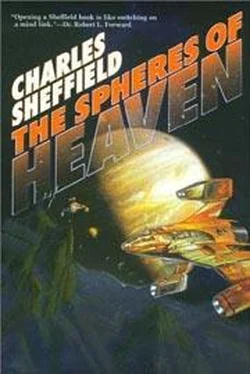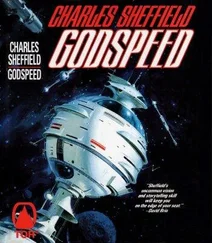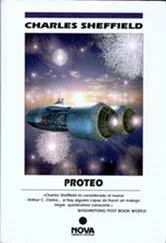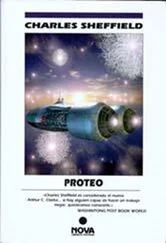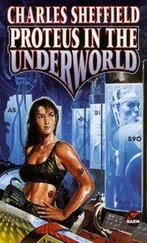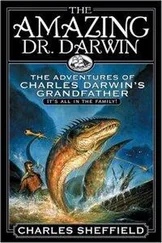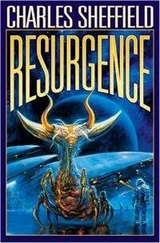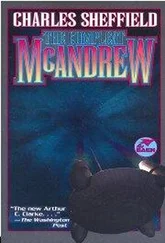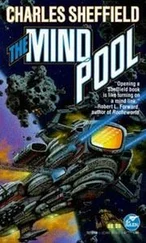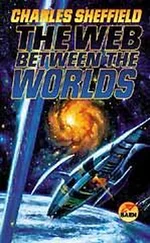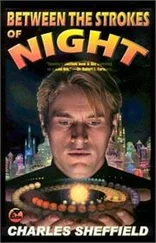He stood still and checked the condition of his suit. He had air enough for eight hours, ample drinking water if he needed it, and good thermal balance. He felt neither too hot nor too cold. The light around him seemed a fraction brighter than when he first emerged. Assuming that they were on the seabed of a planet somewhere in the Geyser Swirl; that the planet rotated on its axis with a period to give it a day comparable in length with an Earth day; and that the planet moved in orbit around a star — lots of assumptions, but each of them reasonable — then the brighter light indicated that it was still morning on Limbo. The only thing at all abnormal was the tendency of his faceplate to become covered with small bubbles. That must be a side effect of the superaerated sea, and it ought to decrease as the suit visor became the same temperature as the water. Bony could go quite a bit farther, without a danger of being caught by darkness. And if he went back now, Liddy would wonder why.
He moved carefully forward, passing across the broken shafts until he came to the array of upright ones. Each standing spear was a couple of centimeters across and rose taller than his head. Close up, he could see a brighter line running up the middle of each. He reached out to take one between finger and thumb, and at once it shattered. He tried again, with the same result. No matter how delicate his touch, the shafts fell in two. As they broke he heard a faint chime like a crystal bell, and the bright line faded within seconds.
If he wished to know what lay farther up the side of the drowned valley, he had to cross the field of spears. Feeling like a ruffian, too ham-handed to touch anything on this planet, Bony pushed his way through. He left behind him an avenue of destruction. If everything on Limbo was like this, the planet should be off limits to humans. It was far too delicate to withstand human contact.
At the edge of the field of spears, Bony halted and turned to look back at the Mood Indigo . The ship had faded to an outline of dark gray. Its dumbbell shape, the rounded bulbous lower part of drive and cargo hold topped by the slightly smaller ovoid of crew quarters, had an oddly out-of-place quality. Here on Limbo it was the Terran vessel, and Bony himself, who were the aliens.
He waved, wondering if Liddy would be able to see him from so far away. He fixed in his mind the contours of the underwater valley, so that even when the ship was out of sight he would have no trouble returning to it. Finally, he turned and began the slow, buoyant walk that would take him up the slope and onto the undersea ridge that marked the end of the valley.
He was almost floating, but in order to make forward progress up the steep incline he still had to put his feet down and exert pressure on the seabed. A carpet of spheres of dull orange-red had replaced the standing pikes, and he could not avoid treading on some of them. They flattened, even under his sea-supported weight of what could not be more than a few pounds; but at least they did not shatter and crumble to dust. Instead they produced an odd wheezing sound, like a chesty old man’s sigh of complaint. When he had passed by, they slowly and silently resumed their original shapes.
Life-forms? Bony was not sure, but his guess was yes. Experience throughout the Stellar Group showed that life popped up everywhere you thought it possibly could, and in a lot of places where you felt sure that it couldn’t possibly. There was life in the sulfur volcanoes of Io, life in the ammonia clouds of Uranus, life on fifty-kilometer fragments of radioactive ice in the far reaches of the Oort Cloud, even viral life of a sort coating arid rock shards of the Dry Tortugas. And this was all within the limits of the extended solar system. When you included the domain of the whole Stellar Group, the variety of life-forms, life-tolerances, and life-locations seemed endless. The idea of life on Limbo seemed very reasonable.
Intelligent life on this planet was another matter. Bony was ready to bet high odds against it. Thousands of worlds lay within the two-hundred-lightyear sphere bounded by the Perimeter, and they had so far produced only four intelligent species: humans, Pipe-Rillas, Tinker Composites, and Angels. There was a debatable fifth form on the far-off planet Travancore, in the form of a giant caterpillar-like creature known as a Coromar. The Coromar was capable of speech, which would normally argue for intelligence; unfortunately its entire vocabulary and interests were confined to finding food and eating it. Bony was as fond of his food as the next man — probably a good deal fonder than the next man — but as far as he was concerned the Coromar failed to make the cut.
And then there were dangerous life-forms. To be dangerous, life did not have to be smart. It merely had to be hungry, poisonous, bad-tempered, territorial, frightened, or accidentally lethal. Bony, as an Earth form, was almost certainly useless as food for any indigenous form on Limbo or any other alien planet. Unfortunately, that was the sort of discovery a creature made only after an attempt at eating had begun.
Occupied by such disturbing thoughts, Bony came to the top of the ridge. He guessed that he had walked maybe two or three hundred meters and risen twenty meters above the ship’s location at the bottom of the valley. Everything was noticeably brighter. He raised his head and stared straight up, wondering how far he was from the surface. When they first arrived, he had guessed at maybe a sixty-meter depth for the Mood Indigo based upon the pressure outside the ship. But that estimate, he now realized, had ignored the air pressure of the atmosphere above the surface of the water. He might be within ten or fifteen meters of air — whatever air on Limbo might be. It must have a high oxygen content, because the waters of Limbo literally fizzed with dissolved oxygen.
The far side of the ridge descended in a shallower slope that seemed to lead to another valley. The seabed structures changed again. Now they formed clumps of long green strands with thick purple fingers at the end of each. Bony decided that he had come far enough for one day. He would, if the ship was still here tomorrow, take a closer look then. He was all ready to turn and head back when he noticed something about the green clumps. Although their height and degree of growth varied so that they covered almost the whole seabed apparently at random, the positions of their centers were not at all haphazard. They lay along a precise triangular grid, each one about half a meter from its three nearest neighbors.
It could happen naturally. For all that Bony knew, the separation was governed by some precise biological demand for light or nutrients. If, on the other hand, it was not natural, but a farm …
Bony sank down on his haunches to examine the nearest clump of plants. He reached out and tugged at one of the purple fingers. It came away easily and split open like a ripe pod, revealing a group of pea-sized objects within. A puff of gas came at the same time, bubbling up into the water. He lifted the pod to the visor of his suit helmet for a closer view of the dimpled seeds. They looked like a food crop, ripely edible — though probably not to humans. One of those might be enough to kill Bony. As he peered at the cluster his peripheral vision caught a movement far away.
They were on the floor of the valley, close to the limit of visibility. Three of them. At that distance, in the diffuse watery gloom, he had no way of judging size. Each one was rounded and iridescent, like an object blown from a collection of different-sized soap bubbles or a figure made by children from balloons, come to life and in its movements oddly ominous. Bony saw — or imagined — a round bubble head supporting bubble eyes that nodded on long thin stalks; a spherical multicolored body; string-of-bubble limbs or tentacles, that carried the creatures across the seabed as though they were floating ghosts.
Читать дальше
